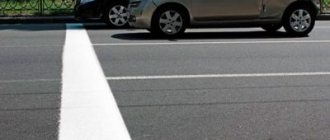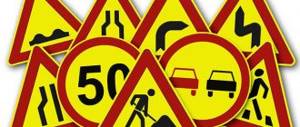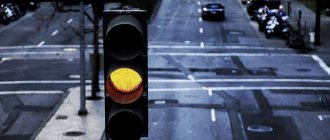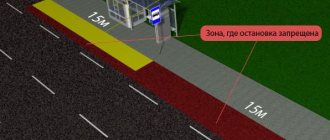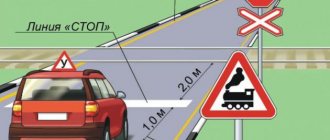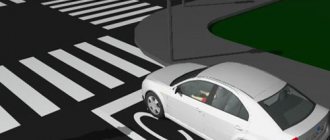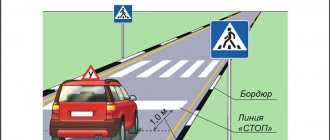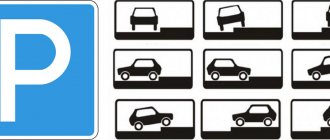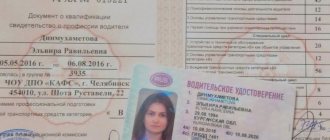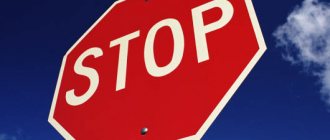What does the sign look like?
Dear readers! The article talks about typical ways to resolve legal issues, but each case is individual. If you want to find out how to solve your particular problem , contact a consultant:
+7 (499) 938-81-90 (Moscow)
+7 (812) 467-32-77 (Saint Petersburg)
8 (800) 301-79-36 (Regions)
APPLICATIONS AND CALLS ARE ACCEPTED 24/7 and 7 days a week.
It's fast and FREE !
Road sign 2.5 “Driving without stopping is prohibited” is known to both pedestrians and drivers. In most countries of the world, it is depicted in the same way: four white Latin letters are written on a red octagon: “STOP”. The edging of the figure is also done in the form of a white stripe.
A special geometric shape is necessary so that the sign can be recognized even if it is dirty, damaged by vandals, or covered with frost or snow.
According to the recommendation of the Vienna Convention of 1968, other variations of the image can be used: a red circle with a triangle located inside with a yellow or white background in the middle.
Black and blue letters are allowed. The UN Convention explains that the word “stop” does not have to be written in Latin: each state has the right to approve a sign made using its official alphabet.
In our country, only the first variety is used. In addition to it, the traffic rules provide information plate 6.16, which is used in conjunction with marking 1.12 “Stop line” or instead of it, marking the border on the roadway before the intersection.
These graphics serve a slightly different function: they inform the driver where in front of a traffic light he needs to stop to wait for the green signal.
Why and where should it stand?
The main functionality is to warn drivers that they need to stop at this place.
This sign must be located:
- at crossroads;
- near railway crossings;
- at the exit to the main road;
- in front of the traffic light.
In front of a stationary sign, special markings are often applied to the road surface and additional signs are placed warning that there is a STOP sign ahead.
The red symbol at the crossing means that you need to make a complete stop and allow the approaching train to pass, if it is in the field of view of the one driving.
If a white signal is on at a three-section traffic light in front of a railway crossing, traffic is allowed, there is no need to stop
A “STOP” sign on a white background is installed near unregulated and controlled pedestrian crossings or traffic lights and unregulated railway crossings. The symbol informs that the motorist may not stop in this place, except when there is a pedestrian at the crossing or the traffic light is prohibited.
When the intersection is regulated, the road signs 2.15 and 6.16 installed on it are not valid
Where and in what cases is it installed
Symbol 2.5 is placed by road services:
- at intersections (both at regulated ones and those where there is no traffic light);
- before a railway crossing;
- at the point of exit from the secondary road to the main one;
- near quarantine posts.
In other words, a “STOP” sign is necessary where driving without stopping a car can lead to serious consequences: that is, on dangerous sections of roads. It is often accompanied by the graphic symbol 1.23 “Caution Children”.
If traffic lights are turned on at an intersection, then the established symbol is not followed, but is acted on the basis of the light signals.
The main mistake drivers make is driving and slowing down to a minimum speed without actually stopping. Such an action would be a violation of the administrative code, which entails a meeting with a traffic police inspector.
Another common situation: two cars drive up to a sign one after another, the one in front stops to comply with its request, the second is forced to do the same.
Many people believe that after the first driver has moved off, they can follow him without stopping the movement. This is not so: near the graphic symbol you should again come to a complete stop for a few seconds.
Where do you need to stop according to the rules?
In most cases, the “STOP” sign is placed together with markings 1.12 on the roadway. In this case, the driver of the car is obliged to stop in front of the line.
If it is missing, then it is necessary to stop driving before reaching the edge of the roadway that you plan to cross, giving way to all vehicles moving along it.
When crossing rails or approaching a quarantine post, you must also stop in front of the marked markings (stop line). If it is not marked, the vehicle must stop moving in front of the sign.
Important! Do not allow the car bumper to be above the markings. Many people believe that if the wheels have not reached the border marked by it, then there is no violation in this.
The recording camera will certainly react to such an action, and the driver will receive a decision to impose penalties.
What is the fine for crossing a stop line at a traffic light in 2021?
The driver legally brakes before the stop line at a red, yellow light or raised rod. If this is not done, the camera will record the violation, the fine is 800 rubles.
In case of repeated violation within one year, the fine will be higher - 5,000 rubles. If the driver is stopped by an inspector, he may require him to surrender his license to the traffic police for up to six months.
If the driver does not brake before the stop line and the STOP sign at an intersection without a traffic light, the fine is lower - 500 rubles. If the violator is stopped by an inspector, you can even get off with a warning.
Coverage area
The graphic road symbol “STOP” is not equipped with accompanying signs indicating the extent of its validity, since this zone is located directly where it is installed.
In this place, it is not allowed for a car to cross an imaginary line running along the roadway, that is, the slightest drive “behind the sign.”
The main point here is that you should see it in time to apply the brakes. In order for the driver to have time to stop, the symbol is usually placed at some distance from the intersection of two roads, and not at the intersection itself.
It happens that on a “blind” turn it is impossible to predict in advance the presence of a sign. Therefore, the driver should slow down and prepare for the possible need to stop.
Sometimes terrain or weather conditions, even if traffic stops, prevent the person sitting behind the wheel from assessing the traffic situation.
It may be advisable to move forward slightly and stop again to make sure it is safe to continue driving. If a traffic jam has formed on the roadway, under no circumstances should you drive beyond the sign, even if the required stop has already been made.
You should wait until it becomes obvious that driving through the intersection is possible, and only then move off.
Sometimes, in order to avoid such unpleasant situations, a symbol is placed on the road in advance indicating the need to give way. It warns you when you are approaching a place where you will need to brake and stop.
An additional information sign indicates how many meters the driver will have to travel to reach the STOP sign.
The use of a child seat in a car according to traffic regulations is discussed in the article: child seat according to traffic regulations. Read here how traffic rules govern traffic lanes at an intersection.
STOP control
A rather rare analogue of the graphic symbol “STOP” is the prohibitory sign “Control” (3.17.3). It obliges the driver of the vehicle to stop driving on the section of the roadway where there is a checkpoint.
It could be:
- police post;
- entering a road that is private property;
- border zone;
- zone where quarantine is introduced;
- evacuation zone;
- area in which there is an emergency situation.
Very often, symbol 3.17.3 is unreasonably placed at the entrance to sea beaches and resorts. Therefore, every driver should know the above cases for which this sign is intended.
When stopped by traffic police officers, you should ask which item the installation of a graphic road object relates to.
When drawing up a protocol for non-compliance with the ban, the decision can be appealed through the court, since in this case it will be unfounded.
STOP line
This graphic road object is an informational one. It notifies the driver about the driving mode requirements for a given area, indicating the place where the brakes should be applied.
This symbol is a rectangle with a white background, on which the inscription “STOP” is written in black in Cyrillic.
The sign is placed mainly in the following cases:
- at unregulated crossings over railway rails;
- at intersections where traffic is controlled by a traffic light or a traffic controller.
The sign can be located directly on the traffic light support, or on a separate holder, as well as above the traffic lane from above. The duplicating function is performed by marking 1.12 “Stop line” applied to the coating.
This is a wide transverse strip made of white paint with reflective properties, which limits the route of the car on the approach to the intersection.
This object is necessary to reduce the likelihood of an accident, since it does not allow you to travel to where vehicles are moving in a perpendicular direction.
If the driver's signal is green, then there is no need to stop in front of these two road objects. When the traffic light control is turned off, the intersection becomes unregulated.
Here you should be guided by the established priority signs: when you are on a secondary road, you need to look left and right and let those who have the right pass.
Traffic stop sign
The STOP sign appeared in the United States in 1915. The first sign was installed in Detroit, Michigan. The need to install it was dictated by the increasing number of cars on the road and the need to regulate traffic.
In order to comply with safety regulations, each country has developed its own symbols for drivers. The USSR was no exception and also regulated traffic with the help of official symbols and tables.
However, the STOP sign appeared in the Soviet Union only in 1973. By this time, the traffic rules already included 105 other graphic symbols. A sign requiring a mandatory stop before further movement was introduced by GOST 10807-71.
Installing signs at unregulated intersections, crossings and dangerous exits helped reduce the number of accidents. When stopping in a difficult area, the driver gets the opportunity to slowly assess the situation and make the right decision about performing further maneuvers.
What does it look like
Today there are two STOP signs in the traffic rules. They differ from each other not only externally, but also in essence in their interpretation.
The main and most important symbol is made in the form of a regular octagon. The general background of the sign is red with a white border around the edge. In the center of the sign is the inscription “STOP” written in white paint. According to the standards for manufacturing plates, it is allowed to apply the main inscription in other colors - black or blue.
The red STOP octagon is a permanent sign, although it is often used on sections of road where increased safety precautions are temporarily being taken. Temporary signs usually have a yellow background with black borders and black lettering. On Russian roads you can find other variations of the graphic plate, but it always retains its shape and the letters STOP written large in the center.
There is another graphic symbol that says "STOP". He looks completely different. A white rectangle with a thin black stripe along the edge and large Russian letters STOP. The word is depicted in black paint.
Where and why is it installed?
The red “STOP” octagon is installed to regulate the movement of vehicles at complex intersections. It is used in populated areas and on the highways between them.
In accordance with GOST R 52289–2004, the sign is placed at uncontrolled intersections, but can also be used in conjunction with a traffic light. When the traffic light is running, the STOP sign does not have priority. However, if the automatic traffic controller does not work, then drivers are required to comply with the mandatory stopping rule.
A STOP sign is placed before the intersection of a secondary and main road, reminding of priority and the need to let other vehicles pass. It is also used at T-junctions where visibility is difficult or limited.
In combination with a graphic symbol, a special marking on the road is usually used - a stop line. She shows the driver the stopping place.
The word STOP written on a white rectangular sign is set:
- at unregulated and regulated pedestrian crossings;
- intersections with traffic lights;
- unregulated railway crossings.
The sign is for informational purposes only and does not require a mandatory stop.
How to pass a sign correctly
According to traffic regulations, the red octagon requires the driver to perform a number of mandatory actions:
- Stopping before the stop line. Hitting a marking is considered a violation. If the line is not drawn, then you should stop before the edge of the road being crossed.
- The stop lasts until other vehicles traveling along the intersecting road or the main road pass. If there is no one, then the movement continues after a 1-2 second delay, which is necessary to assess the situation.
- At railway crossings, a complete stop is required even if there is no traffic on either side. It is forbidden to simply slow down and continue moving further. When the traffic light is running, the rule does not apply.
The stopping time depends on the presence of other vehicles that need to be passed or their absence.
Fines for traffic violations
If a person sitting behind the wheel of a moving car ignores the requirement of a STOP road sign and does not stop moving along the roadway for at least a couple of seconds, this will be considered a violation.
Responsibility for such an act is provided for in Part 1 of Art. 12.19 Code of Administrative Offenses of the Russian Federation. The traffic police inspector will issue a decision to impose a sanction on the driver in the form of a fine, the amount of which will be 500 rubles .
A person who has committed a violation in the capital or in St. Petersburg will be prosecuted under Part 5 of Art. 12.19 of the code and will already pay 2000 rubles.
If, if the order of behavior prescribed by the sign is not observed, an obstacle is created to the normal movement of other vehicles, the punishment will be determined based on Part 4 of Art. 12.19 Code of Administrative Offenses of the Russian Federation.
In this case, the violator will also have to pay an amount of 2000 rubles . In Moscow, as well as in St. Petersburg, such an action will be punishable by a fine of 3,000 rubles.
Part 2 Art. 12.12 of the Code contains punishment for non-compliance with traffic rules regarding the need to stop in front of the “Stop line” sign or corresponding markings 1.12. The driver who ignored these graphic objects will be punished in the amount of 800 rubles .
We must not forget about the responsibility that late payment of a fine entails. By law, the entire amount must be transferred to the account of the Ministry of Internal Affairs no later than 60 days after the resolution comes into force.
If the deadline is not met, the person may face:
- double the fine (while the obligation to pay the first remains);
- assignment of compulsory work;
- use of arrest.
If the driver is confident that he is right, he has 10 days to file a complaint with the court against the inspector’s unreasonable decision.
In a controversial situation, it is best to use the video camera of your mobile device to record what is happening. This way a person will have a much better chance of defending his case in court.
If the ruling is overturned and the case is dismissed, you will not have to pay anything. Moreover, the driver has every right to file a claim with the judicial authorities, in which he may demand compensation for moral damage caused by the unfair actions of the police.
If the offense is obvious, the fine should be paid as soon as possible. According to the current code, if the driver manages to do this no later than 20 days from the inspector’s decision, then he has the right to transfer only half of the amount. However, the fine will be considered paid in full.
In most Russian megacities, traffic congestion is a daily occurrence. One of the reasons for their formation is that cars enter intersections when they are not allowed to do so.
An obstacle to traffic created in one place creates a “traffic jam” over a long road: the violating driver punishes himself and everyone else.
That is why it is important to respect the priority established by signs and markings.
About entering the roundabout according to traffic rules, see the article: roundabout traffic according to traffic rules. For parking rules in residential areas according to traffic rules, see the page.
For how long according to traffic rules you can stop if there is a “no stopping” sign, find out from this information.
Typical mistakes in interpreting a sign
Due to the many nuances in the interpretation of road signs and the large number of traffic rules, not all drivers correctly interpret the provisions of the law. What does the stop sign mean and how to act with it?
Let's look at typical mistakes and correct actions in specific situations:
- When two cars were moving close together, after the first one braked, the second one passed behind it. According to the rules, every car must brake at a line or sign.
- When moving parallel and stopping at the same time, both vehicles start at the same moment. The car on the right should start moving first.
- The car starts moving immediately after stopping. It is allowed to start only if there are no pedestrians or other cars on the road.
- The driver started without assessing the speed of the cars crossing his path. The rules stipulate that he has the right to drive only if other road users are driving at the permitted speed. The restrictions ensure that the car has time to brake in an emergency.
As a recommendation, but not a rule, it is indicated to allow cars passing in the opposite direction to pass in the direct direction.
Also, one of the typical offenses is not using your turn signals. Thus, a stop sign indicates where a vehicle should stop. There are several basic recommendations for drivers. Firstly, if the symbol is visible in the distance, it is recommended to reduce your speed. Secondly, each car and in a certain situation has a different braking speed, so it is worth doing this in advance. Thirdly, you must come to a complete stop; you do not need to turn off the engine, but the speed must be at zero. Fourthly, before starting, it is important to assess the type of intersection. Fifthly, before starting to drive, the driver should look around and determine the presence of people and other vehicles with whom a collision may occur. Sixthly, it is important to let all cars and other vehicles pass, if this is provided for by traffic regulations. After passing, continue to adhere to the speed limit.
If there is a stop sign, stopping is mandatory, even if there are no other road users and good visibility.
